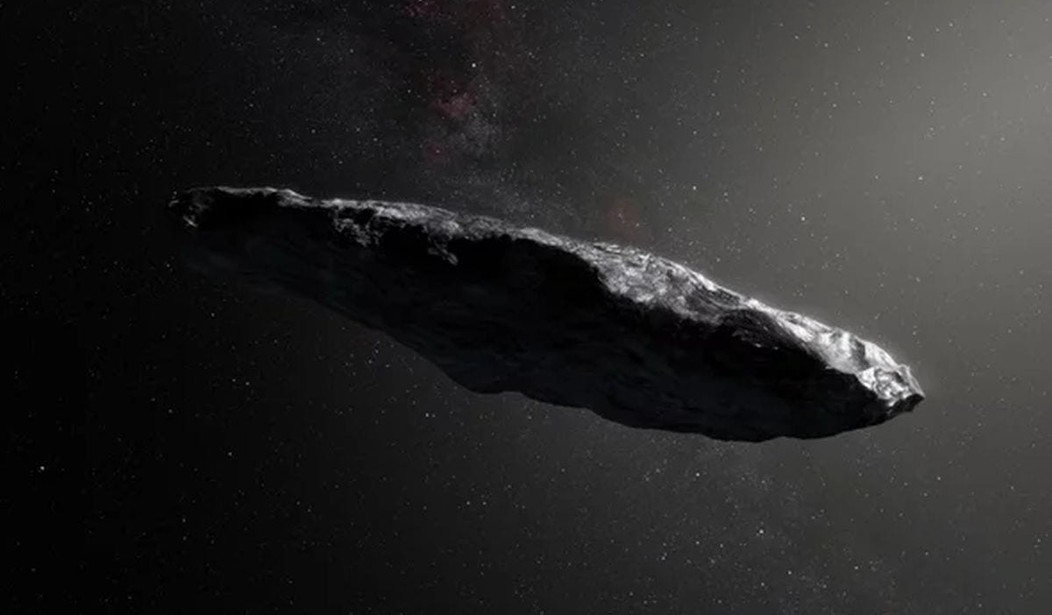“Oumuamua” (Hawaiian for “first messenger”) is the name given to one of the more bizarre objects ever to enter our solar system. Scientists believe it to be an “interstellar asteroid” that wandered — or deliberately flew — within a couple of million miles of earth. They believe it may have originated in an alien solar system, which, if confirmed, would make it the first such object glimpsed by telescopes.
It certainly is weird.
Zooming down almost perpendicularly inside Mercury’s orbit at tens of thousands of kilometers per hour—too fast for our star’s gravity to catch—‘Oumuamua appeared to have been dropped in on our solar system from some great interstellar height, picking up even more speed on a slingshot-like loop around the sun before soaring away for parts unknown. It is now already halfway to Jupiter, too far for a rendezvous mission and rapidly fading from the view of Earth’s most powerful telescopes.
Astronomers scrambling to glimpse the fading object have revealed additional oddities. ‘Oumuamua was never seen to sprout a comet-like tail after getting close to the sun, hinting it is not a relatively fresh bit of icy flotsam from the outskirts of a nearby star system. This plus its deep red coloration—which mirrors that of some cosmic-ray-bombarded objects in our solar system—suggested that ‘Oumuamua could be an asteroid from another star. Yet those same observations also indicate ‘Oumuamua might be shaped rather like a needle, up to 800 meters long and only 80 wide, spinning every seven hours and 20 minutes. That would mean it is like no asteroid ever seen before, instead resembling the collision-minimizing form favored in many designs for notional interstellar probes. What’s more, it is twirling at a rate that could tear a loosely-bound rubble pile apart. Whatever ‘Oumuamua is, it appears to be quite solid—likely composed of rock, or even metal—seemingly tailor-made to weather long journeys between stars.
The only thing this object proves is that the more we learn about our universe the more bizarre and weird it becomes. Colliding neutron stars sending out more energy than our sun generates in 100 billion years; solar-system size Quasars that give off more light than 429 trillion suns; strange and wonderful exoplanets, and closer to home, a gigantic, ice covered ocean on Jupiter’s moon Europa. Many of the strange and marvelous phenomenon scientists are excited about have been discovered since the turn of the 21st century — and we’re just getting warmed up.
But what about this alien “visitor”? It has the SETI community (Search for Extraterrestrial Intelligence) excited at some of the possibilities.
So far limited observations of ‘Oumuamua, using facilities such as the SETI Institute’s Allen Telescope Array, have turned up nothing. But this Wednesday at 3 p.m. Eastern time, the Breakthrough Listen project will aim the West Virgina-based 100-meter Green Bank Telescope at ‘Oumuamua for 10 hours of observations in a wide range of radio frequencies, scanning the object across its entire rotation in search of any signals. Breakthrough Listen is part of billionaire Yuri Milner’s Breakthrough Initiatives program, a collection of lavishly-funded efforts aiming to uncover evidence of life elsewhere in the universe. Other projects include Breakthrough Starshot, which intends to develop and launch interstellar probes, as well as Breakthrough Watch, which would use large telescopes to study exoplanets for signs of life.
“With our equipment at Green Bank, we can detect a signal the strength of a mobile phone coming out of this object,” Milner says. “We don’t want to be sensational in any way, and we are very realistic about the chances this is artificial, but because this is a unique situation we think mankind can afford 10 hours of observing time using the best equipment on the planet to check a low-probability hypothesis.”
I recall when Congress gave SETI $10 million over ten years to get the program off the ground, there were a lot of complaints from members who saw it as a waste of money. (This, coming from people who sneeze and spend a couple of million dollars). As it turns out, Congress repealed funding after two years, but the point was made. Even if it’s a one in a million — or a billion — shot, the effort must be made because of the potential impact on humanity.
SETI no longer uses taxpayer funds and Milner can spend his money any way he wishes. Those who believe the effort to discover if the asteroid was built by someone is a waste of resources are right — in one sense; the ordinary definition of the terms success and failure. They will fail and go back to the equally problematic method of searching the sky for radio signals that suggest intelligence.
But any effort with even a tiny chance of success to find alien life, must be attempted. This is the first moment in human history a search for alien intelligence with a chance of success can be conducted. Rather than criticize and laugh, I would think we’d want to feel pride in our species for our never ending quest for knowledge and understanding of the universe.










Join the conversation as a VIP Member